Diesel Service Report, July 31, 2022
SF560 Restoration
In the last report, we mentioned that the wheels had flanges that were too tall and needed to be turned down. The wheel treads do not have enough metal left to return them to a correct, as new, profile but the wheel flanges can be cut down. Carl Pickus used the portable lathe and cut down three of the four wheel sets. Those three turned out fine.
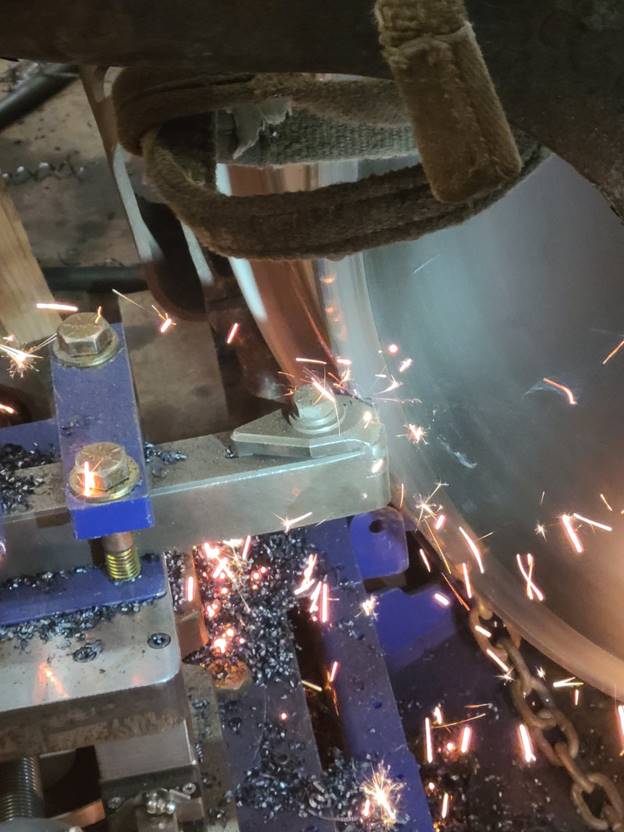 This shows the portable lathe as it is cutting the wheel metal. This shows the lathe as he is cutting metal on the outside portion of the tread. That was needed to reduce the slope of the wear in the middle of the wheel and to clean up the outside of the wheel where steel had been squeezed and work hardened over the edge of the wheel.
This shows the portable lathe as it is cutting the wheel metal. This shows the lathe as he is cutting metal on the outside portion of the tread. That was needed to reduce the slope of the wear in the middle of the wheel and to clean up the outside of the wheel where steel had been squeezed and work hardened over the edge of the wheel.
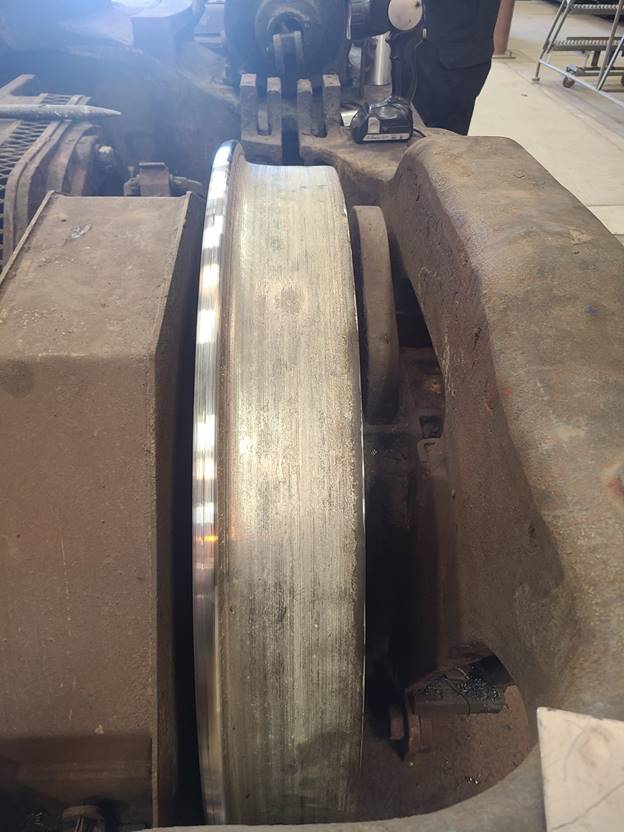
After the lathe work, the wheels that he turned, looked usable for our museum use.
When Carl started to prepare the 4th wheel set for turning, he and Frank Kunsaitis heard loud clunking noises coming from the traction motor gear area. Either the traction motor has a bad bearing, or the pinion gear or bull gear are damaged. From experience we know the cost of repairing these types of problems and have decided to replace that traction motor and wheel set combination, commonly called a “combo”.
Of course, we don’t have spare Fairbanks Morse combos but have the next best option. It turns out that Baldwin locomotives that were built with AAR type A switcher trucks, used the exact same parts as used by Fairbanks Morse. We just happened to have two of those Baldwin locomotives and one specifically has been identified as a parts supply engine.
A comparison of gear ratios indicates that Baldwin and our model of Fairbanks Morse locomotives both used 68/14 gear ratios. But we also know that there were other gear ratios available if locomotive buyers wanted some ratio other than what was considered standard. Normally we would go through the effort to count the teeth on the traction motor pinion gear to prove what the gear ratio is but in this case we will have to use whatever it is.
Essentially there would be no operational impact if the ratios are slightly different because the two traction motors are wired in series and have the exact same current going through them. That will mean that if the gear ratios are slightly different, one traction motor will be working just a little bit harder than the other. In our museum use, that’s not an issue. The reality is that most likely the gear ratios are the same.
John Salvini and Carl then jacked up one of the Baldwin traction motors and connected it to a DC welder to make sure it would be OK to use. It operated properly but did have a little bit of clunking noise in the gear area. At that point we knew we could use that combo in the Fairbanks Morse.
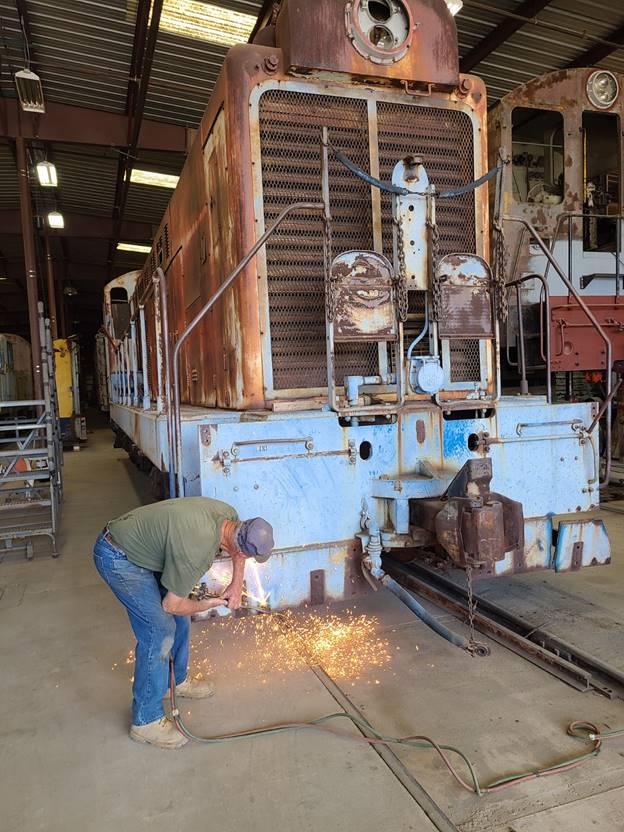 The next job was to get that combo out from under the Baldwin. The Baldwin was put on track 4 in CB7. The truck would be pulled out from under the front of the locomotive, so it was necessary to cut way a part of the front of the locomotive to make room for the truck to come out. Carl also removed the lower steps for added clearance.
The next job was to get that combo out from under the Baldwin. The Baldwin was put on track 4 in CB7. The truck would be pulled out from under the front of the locomotive, so it was necessary to cut way a part of the front of the locomotive to make room for the truck to come out. Carl also removed the lower steps for added clearance.
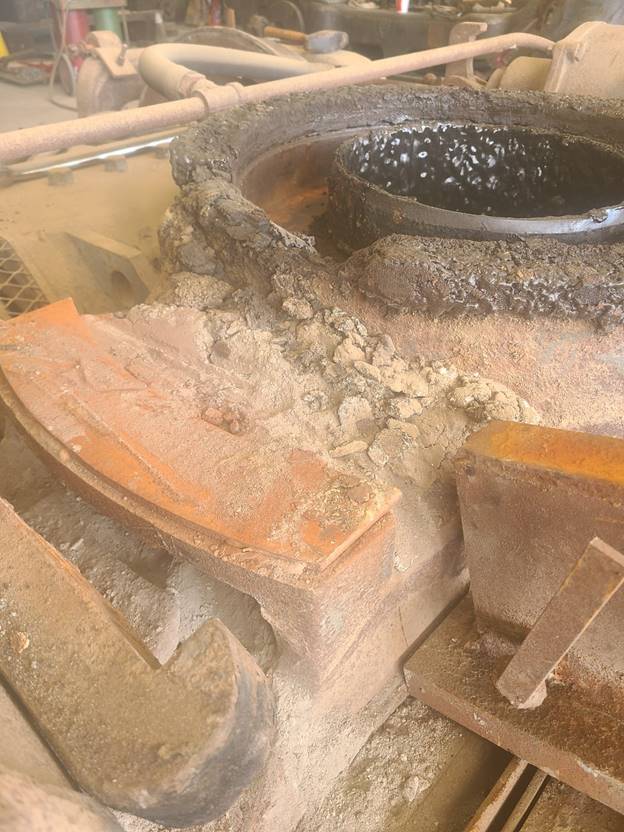 All locomotives have special retaining clips that keep the truck attached to the locomotive body in case of an accident where the truck might come loose from the locomotive. Of course those clips have to be removed before the truck can be removed. The bolts holding the clips in placed were torched off and the clips removed. But it was very difficult because there is little room to work in around that area. Plus that area was packed with old potash from the mine where this locomotive worked in Trona CA. Potash is a salt mineral and is very corrosive. That means that almost everything on the locomotive is corroded and rusted solidly in place. The orange rusty looking area on the left of this picture shows the are where the clips are located. Notice the pile of potash sitting all around there.
All locomotives have special retaining clips that keep the truck attached to the locomotive body in case of an accident where the truck might come loose from the locomotive. Of course those clips have to be removed before the truck can be removed. The bolts holding the clips in placed were torched off and the clips removed. But it was very difficult because there is little room to work in around that area. Plus that area was packed with old potash from the mine where this locomotive worked in Trona CA. Potash is a salt mineral and is very corrosive. That means that almost everything on the locomotive is corroded and rusted solidly in place. The orange rusty looking area on the left of this picture shows the are where the clips are located. Notice the pile of potash sitting all around there.
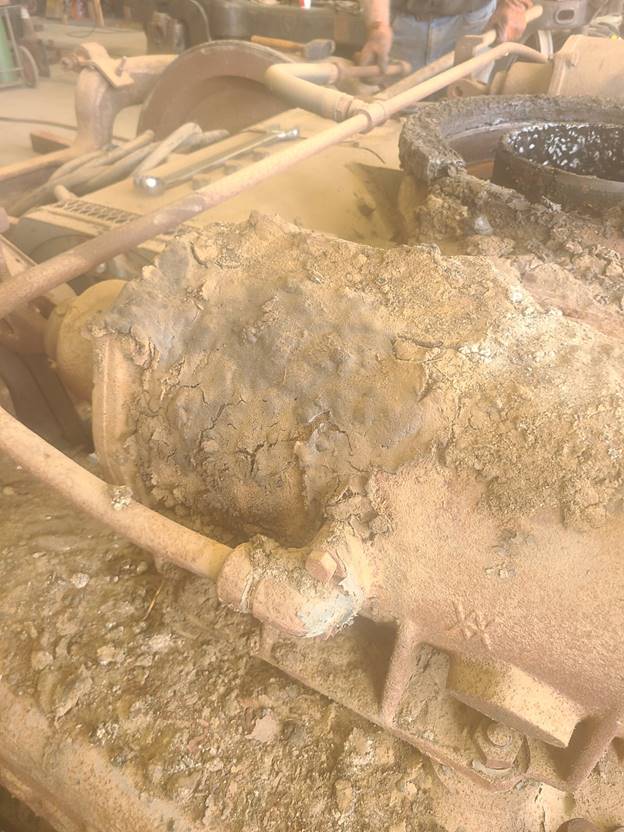 And every place under the locomotive is like that. This shows the top of one of the brake cylinders on the truck.
And every place under the locomotive is like that. This shows the top of one of the brake cylinders on the truck.
After the clips were removed, it was time to jack up the locomotive in order to pull out the truck. Fortunately for us, our good friend from back east, Eric Levin, was visiting for the day. He owns a number of locomotives and is very familiar with how to jack locomotives and pull out trucks. Eric, Carl, Frank, and John jacked up the locomotive and got it read to pull out the truck. It was finicky placing the jacks in the exact correct position but it was finally ready to be pulled out.
Carl then used his deck crane as a tow vehicle and attached a chain to the truck and began to pull. The truck would not move. After a few more, slightly aggressive tugs, it moved a few inches. John then noticed that the back wheel set under the truck was dragging on the track. There was nothing we could do about it so Carl just kept pulling and drug the truck out from under the locomotive while the back wheel set was skidding on the track. That was very odd to say the least.
This shows the truck as is it just starting to come out from under the locomotive, with the one wheel set sliding on the track. A complete truck like that weighs approximately 17 tons. Carl’s crane can pull 7000 lbs and it was just barely able to move the truck.
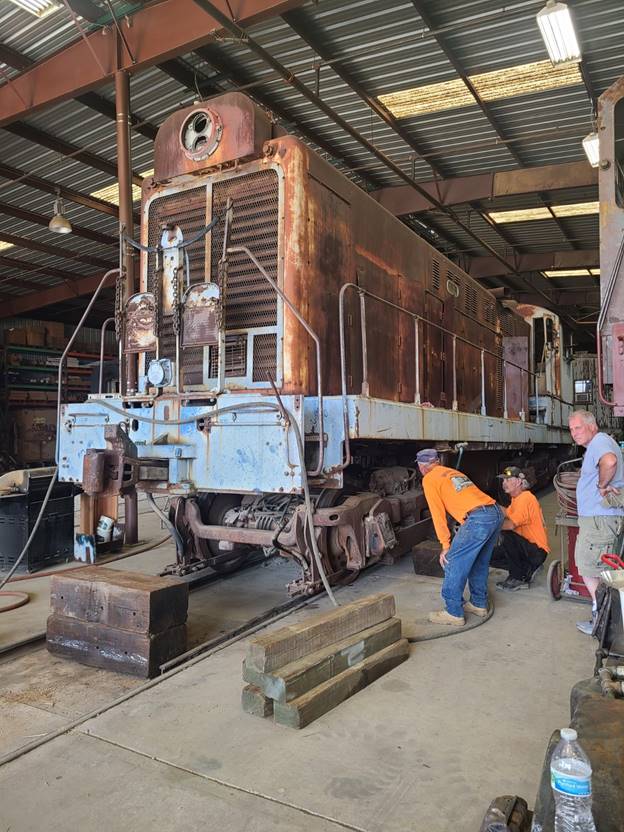
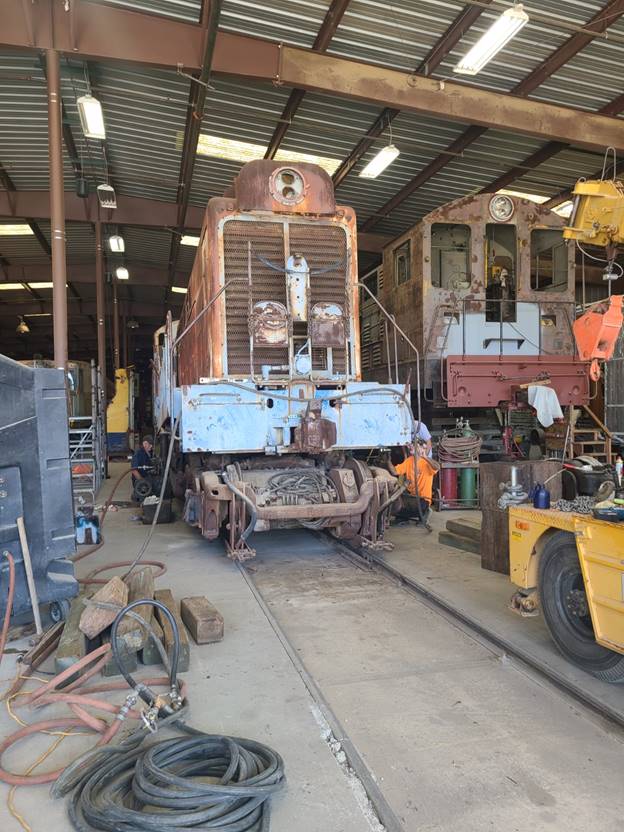
After the truck was out, it was obvious what was wrong. The brake shoes were tight up against the wheels and had rusted in that position, pushing hard on the wheels. The brake swing hanger pins were removed in an attempt to release the brakes but that didn’t work either. The potash had totally frozen the swing hangers to the break shoe heads and the brake shoes to the head. The whole brake assy was just one solid piece of corroded metal. John was able to use a large pry bar to pry the brakes away from the wheels. After he did that, the wheels rolled freely.
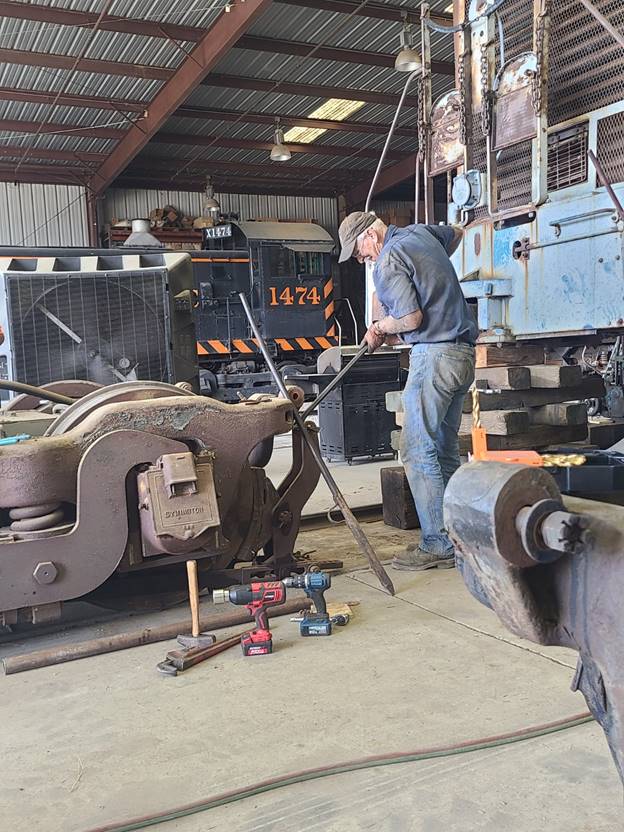 But we still needed to remove the brake rigging in order to remove the combos. There was no reasonable way to disassemble the brake rigging because of the corrosion so it was decided to torch off the straddle bars, remove all the swing arm pivot pins and remove the brake assemblies as a single piece. Once they were all removed, there was then room to pull out the combos.
But we still needed to remove the brake rigging in order to remove the combos. There was no reasonable way to disassemble the brake rigging because of the corrosion so it was decided to torch off the straddle bars, remove all the swing arm pivot pins and remove the brake assemblies as a single piece. Once they were all removed, there was then room to pull out the combos.
But before the combos are pulled out, the second combo, the one that was stuck, will be tested to see if it runs any quieter than the first one that was tried. Hopefully it does run OK. The reason is that the first combo not only had a slight clunk in the gear train but John also noticed that the gear case was cracked. We really don’t want to have to deal with repairing gear cases. That is a terrible messy job and very difficult to do. We should have those answers next week.
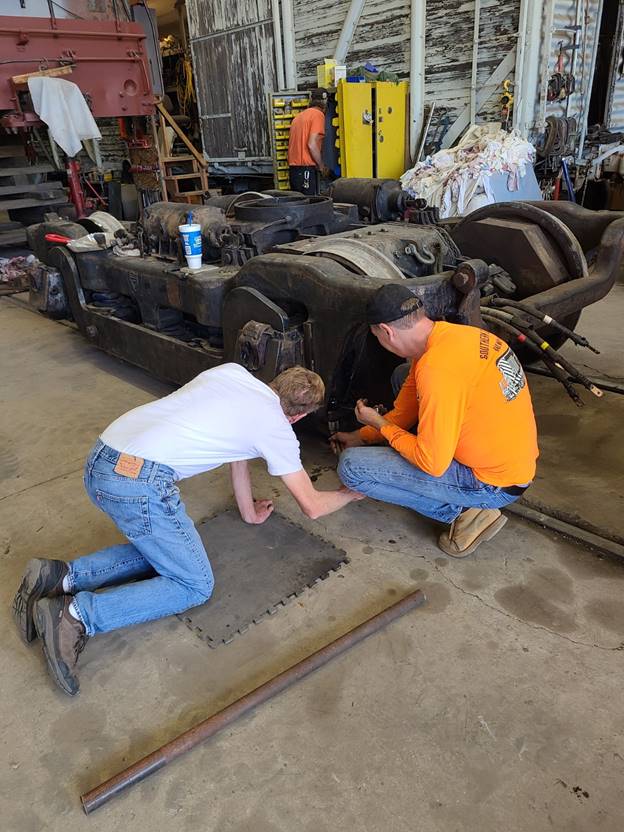 Tim Johnson and Bob Bray removed the pedestal tie bars from under the Fairbanks Morse truck combo that will be replaced. This is about the third time those tie bars have been on and off during this project.
Tim Johnson and Bob Bray removed the pedestal tie bars from under the Fairbanks Morse truck combo that will be replaced. This is about the third time those tie bars have been on and off during this project.
John measured the Fairbanks traction motors and the Baldwin traction motors for electrical resistance to the motor chassis. Typically we are glad to see 10 meg ohms or better. In the case of all four motors, they were 175 meg ohms or higher. Those were excellent readings.
As he has for the past number of months, Tom Platten continues the task of removing years of accumulated dirt and oil from under the locomotive. The locomotive leaked oil for years while it was in Texas and that, along with West Texas dust, built up thick layers of hard material that has to be chiseled off. It has been a major task cleaning the underneath of the locomotive.
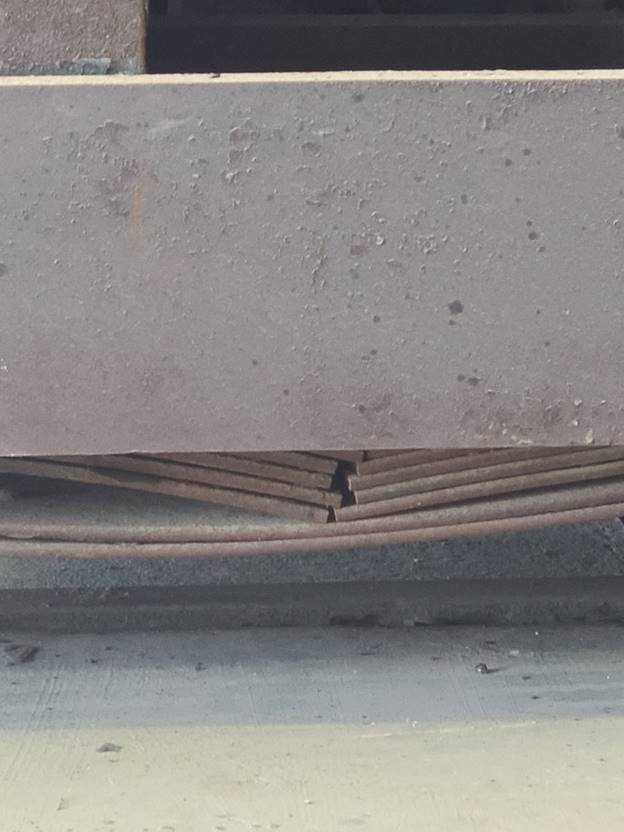
The Baldwin that is acting as the donor of the combo has other major issues. The spring packs on the truck are totally broken. And the Diesel engine is frozen solid and will not turn over. The best guess is that the main generator is actually what is frozen but we have no way of easily determining which is at fault. This shows the spring pack under the truck that we are removing the combos from.
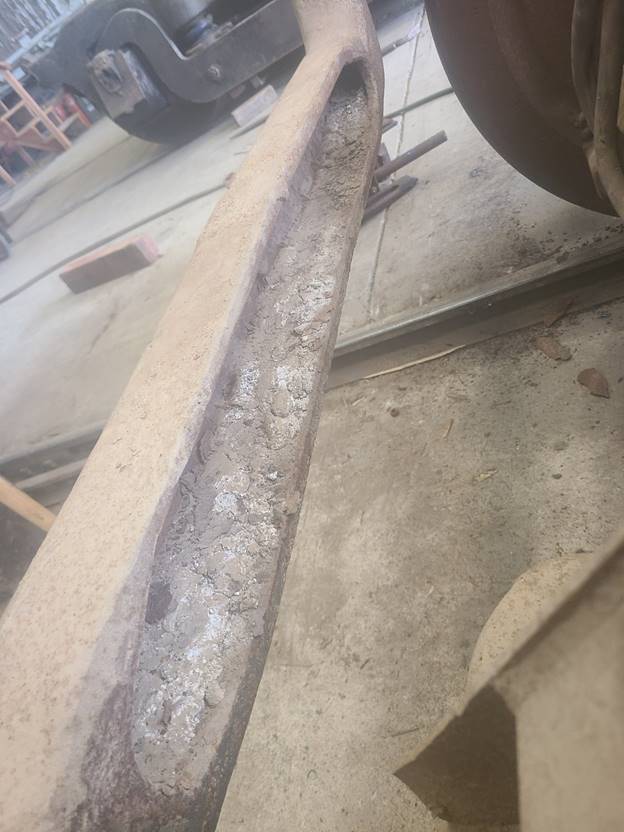 And as we look further into the frame of the truck, we see that it also is packed full of potash. That stuff is everywhere in the locomotive and essentially was the reason for our having to say that this locomotive could never be reasonably restored.
And as we look further into the frame of the truck, we see that it also is packed full of potash. That stuff is everywhere in the locomotive and essentially was the reason for our having to say that this locomotive could never be reasonably restored.
– Dave Althaus

